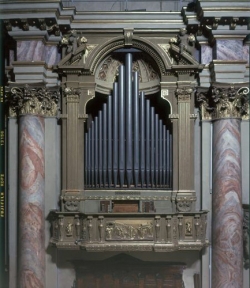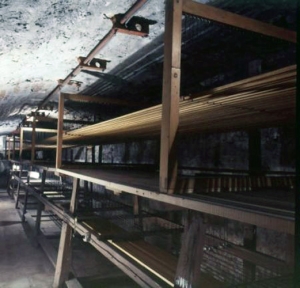


Bergamo, S. Alessandro in Colonna


Giuseppe Serassi 1778-1781
State of preservation: Organs and mechanisms were changed during the 19th c.; the original mechanical links between the organs were placed under the presbytery with 80 trackers of 33 m each. The links were dismantled in 1887 by Adeodato Bossi and reconstructed 1970. Restored by Tamburini 1970-75.
The instrument consists of two opposing organs played on one console with mechanical action.This construction fulfils with enormous effort a dream shared by many an organ maker and planner to connect the traditional pair of Gospel and Epistle organs with a common console. Something like this had been planned more often, like in Ottobeuren, but was hardly ever realised because of the gigantic efforts and costs. Giuseppe Serassi found a solution with a common console on the Epistle side and long trackers under the floor.
Serassi's organ style indicates the growing influences from France or Germany in Italy which formed the aesthetics of the 19th century. The advance of flute, strings and reed stops as well as compound stops like the french-style "Cornetto" 3f. is clearly visible here, even if some may be added during the frequent alterations of the 19th century.
Specification
Manual C-f3 (division between b0/c1); pedal C-b0 (C-B repeated one octave higher)
The stops marked B/S (= „Bassi“/„Soprani“) have divided sliders.
The organ is in three divisions:
Organo principale “Organo in cornu epistolae” (Epistle organ) - Organo Eco - Terzo Organo “Organo in cornu evangeliae” (Gospel organ)
(stops on the right:)
Principale (B+S) 16’(+8’)
Principale primo (B+S) 8’
Principale secondo (B+S) 8’
Ottava (B+S) 4’
Duodecima 2 2/3’
Decimaquinta 2’
Decimanona 1 1/3’
Vigesima seconda 1’
Ripieno 2f.
Sesquialtera 3f.
Cornetto primo 3f.
Cornetto secondo 3f.
Clarino (B+S) 8’
Fagotto B/Trombe S 8’
Viola Bassi 4’
Flutta Soprani 8’
Flauto in ottava Soprani 4’
Flauto in duodecima (B+S) 2 2/3’
Voce umana 8’
(stops on the left:)
Principale 8’
Voce umana 8’
Violoncello 8’
Ottava 4’
Flauto in ottava 4’
Decimaquinta 2’
Decimanona 1 1/3’
Vigesima seconda 1’
Sesquialtera 4/5’
Vigesima sesta 2/3’
Vigesima nona ½’
Cornetto 3f.
Pedale:
Contrabassi con Ottave 16’+8’
Duodecima di Contrabassi 5 1/3’
Ripieno al Pedale
Bombarde ai Pedali 16’
(couplers, most added 19th c.):
Unione Grand-Organo al Pedale
Unione Eco al Grand-Organo
Unione Gran-Organo al Terzo Organo
Tiratutti del Ripieno
Tiratutti del Ripieno al Terzo Organo
Tiratutti preparabile o Combinazione libera
Tiratutti preparabile al Terzo Organo
Ance Grand-Organo
Ripieno Eco
Violoncello Eco
Tromba Terzo Organo
Mezzo Ripieno Terzo Organo
Q: http://www.provincia.bergamo.it/OrganiStorici/out/eng/or241000186.htm
© Greifenberger Institut für Musikinstrumentenkunde | info@greifenberger-institut.de



